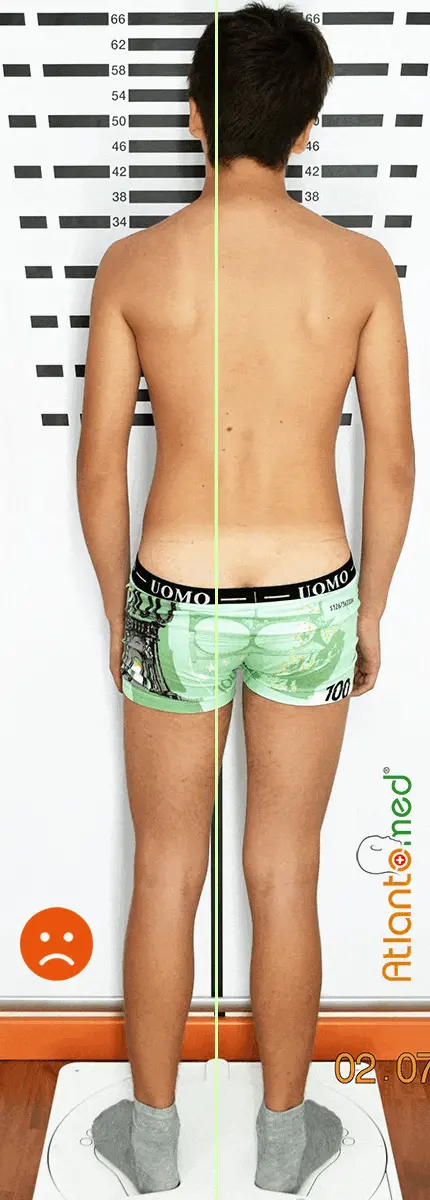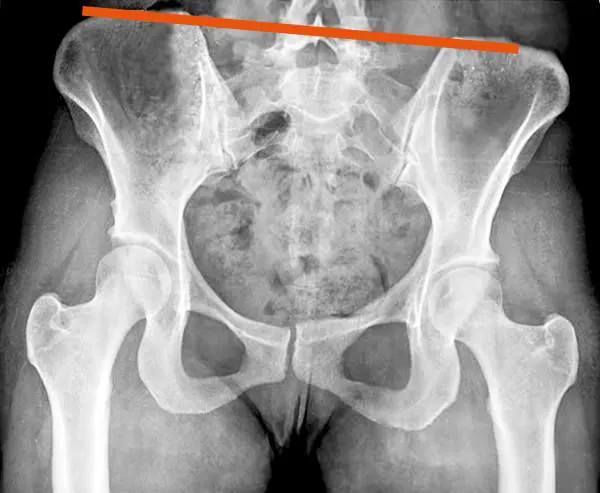Tilted pelvis – Asymmetry of the pelvis

PRIMA
DOPO
Pelvic asymmetry (pelvic dysmetria) or rotation of the pelvis can be the result of a misaligned Atlas or a cranio-mandibular dysfunction, contrary to what the old doctrines teach, without really solving the problem.
Why do we say this? Quite simply because after having corrected the Atlas with the help of vibro-resonance, we often find that the pelvis is level, without the need for further intervention. If this does not occur, or if the rebalancing is only partial, the reason is almost always the presence of an important mandibular dysfunction.
There are other concomitant causes that can induce or aggravate pelvic obliquity, but they are in a minority of cases and are beyond our scope. Just to mention one, we refer to adhesion of fascial tissue by untreated scars.
Due to our practice of photographing all people before and after the realignment, as well as during the second session after an interval of 5-7 weeks, we have an incredible amount of data to support our claim. We don't know of anyone else who uses such a meticulous approach.
You can learn more about the mechanism behind the crooked pelvis here: importance of Atlas corrections.
The asymmetry of the pelvis causes the sensation of one leg being longer than the other, when in fact it is not. A chronically tilted pelvis has negative effects on the hip joints, knees, feet and intervertebral discs.
You can easily check if your pelvis is crooked by looking in the mirror: is one hip bone higher than the other? Another characteristic of a tilted pelvis is this: when you stand, do you tend to bend one knee while balancing on the other leg? If the answer is yes, your pelvis is most likely crooked.
The levelling of the pelvis can occur immediately after the Atlantomed treatment or as the muscle chains rebalance.
Why do we say this? Quite simply because after having corrected the Atlas with the help of vibro-resonance, we often find that the pelvis is level, without the need for further intervention. If this does not occur, or if the rebalancing is only partial, the reason is almost always the presence of an important mandibular dysfunction.
There are other concomitant causes that can induce or aggravate pelvic obliquity, but they are in a minority of cases and are beyond our scope. Just to mention one, we refer to adhesion of fascial tissue by untreated scars.
Due to our practice of photographing all people before and after the realignment, as well as during the second session after an interval of 5-7 weeks, we have an incredible amount of data to support our claim. We don't know of anyone else who uses such a meticulous approach.
You can learn more about the mechanism behind the crooked pelvis here: importance of Atlas corrections.
The asymmetry of the pelvis causes the sensation of one leg being longer than the other, when in fact it is not. A chronically tilted pelvis has negative effects on the hip joints, knees, feet and intervertebral discs.
You can easily check if your pelvis is crooked by looking in the mirror: is one hip bone higher than the other? Another characteristic of a tilted pelvis is this: when you stand, do you tend to bend one knee while balancing on the other leg? If the answer is yes, your pelvis is most likely crooked.
The levelling of the pelvis can occur immediately after the Atlantomed treatment or as the muscle chains rebalance.
Manual therapies for pelvic asymmetry
Manual therapists, such as physiotherapists and osteopaths, try to realign the crooked pelvis with specific manipulative techniques, stretches or massages.As most patients with a crooked pelvis can confirm, the effects of these manipulations are only temporary. After a short period of time, the pelvic tilt will return, forcing the patient to have regular therapy sessions in order to get by without too much pain. In the long term, the disorder tends to become chronic, creating a breeding ground for herniated discs, lower back pain and witch's strikes.
This happens because the cause of the crooked pelvis, which often lies in misalignment of the Atlas and/or the jaw, is not taken into account, nor is an effective solution found.
Physiotherapists and osteopaths do not have a technique as good as Atlantomed and even if they do their best with the techniques at their disposal, they do not succeed in obtaining lasting results and end up convincing themselves that there are no alternatives. If anyone dares to claim otherwise, they are branded as charlatans. The same applies to other problems that can be solved with Atlantomed, in spite of all those who claim that these problems cannot be cured. Thousands of testimonies of people who have definitively resolved them are not enough to convince them otherwise. There is none so blind as those who do not want to see.
What about the jaw problem? The crooked pelvis is not the responsibility of the classic dentist, who is usually not even aware of the correlation between dental occlusion and posture. At the same time, teeth and malocclusions do not fall within the competence of the therapist or orthopaedist, who at best try to intervene on the jaw at a muscular level. Each one works in its own field of competence, with the consequence that the cranio-mandibular system and the musculoskeletal system are not considered and treated as a whole. The result is that there is never a permanent solution for the patient.
The functional inclination of the pelvis
With this animation you can finally understand how the so-called 'shortest leg' works and why what is commonly said about it is wrong.
If the pelvis does not rebalance completely after treatment, the cause is dental malocclusion accompanied by craniomandibular dysfunction or untreated scars. Congenital scoliosis or degenerated hip and/or knee cartilage due to arthrosis, as well as the problem of flat feet, may also prevent complete balancing.
Pelvic tilt according to doctors and orthopaedists

When you go to the doctor or orthopaedist with a crooked pelvis, you are usually diagnosed with one leg being shorter than the other.
This is absolutely not the case! Less than 4% of people actually have legs of different lengths (heterometry), as a study by Burkhard Hock has shown.
96% of cases with a tilted pelvis have only a functional imbalance of the musculoskeletal system, which involves a forward or backward rotation of one hip relative to the other. As you have seen in the video, this rotation makes the legs appear to be different lengths. Rotation of the pelvis can also be the consequence of lumbar scoliosis.
In cases of a twisted pelvis, the orthopaedist or doctor usually performs an X-ray of the pelvis to "accurately" diagnose pelvic dysmetria.
This is absolutely not the case! Less than 4% of people actually have legs of different lengths (heterometry), as a study by Burkhard Hock has shown.
96% of cases with a tilted pelvis have only a functional imbalance of the musculoskeletal system, which involves a forward or backward rotation of one hip relative to the other. As you have seen in the video, this rotation makes the legs appear to be different lengths. Rotation of the pelvis can also be the consequence of lumbar scoliosis.
In cases of a twisted pelvis, the orthopaedist or doctor usually performs an X-ray of the pelvis to "accurately" diagnose pelvic dysmetria.
What the doctor interprets as a shorter leg on the X-ray is the error in perspective of one hip being spatially further forward or further back than the other (depth dimension), which in a two-dimensional (2D) view, such as a simple X-ray, appears as "one hip higher than the other" instead of "one hip further forward than the other" as it actually is in three-dimensional (3D) reality.
How many years has the practice of measuring a crooked pelvis in this way existed? How do orthopaedists compensate for this error in perspective and understanding? With an orthopaedic insole!
What do you think is involved in wearing an orthopaedic insole, which in fact artificially alters the length of legs that are actually the same length?
Simple! Back pain often increases, because an additional element of imbalance is introduced into the skeletal system! They will tell you that the body has to get used to it. With the orthopaedic insole, they usually only compensate for part of the difference in height that they think they have measured on the X-ray, otherwise the pain would become unbearable.
Orthopaedic insoles can only be helpful in 4% of cases where there is actually a difference in the anatomical length of the legs (heterometry), and in the remaining 96% they are even harmful, as many patients can confirm. After the body has become accustomed to being crooked with insoles, removing them increases the pain again; the body has to get out of the habit. In fact, insoles are addictive.
After many years of 'we've always done it this way', proprioceptive orthopaedic insoles, which stimulate the foot without creating an actual rise, are gaining popularity.
Doctors, orthopaedists and therapists from various disciplines are instructed to look at the musculoskeletal system from the bottom up (ascending). At first glance, it might seem logical that a tilted pelvis depends on a different leg length. It is a pity that a closer look at the functional mechanism reveals a much more complex system that can be influenced by many variables, which are ignored by the banal old orthopaedic theories that analyse complex dynamic systems only statically.
Videointerviste bacino inclinato
racconti dopo il riallineamento dell'Atlante
Alcune testimonianze dal forum
- Pinuccia65: Asimmetria del bacino: adesso sono senza plantare!!
- @ALEX@: Bacino inclinato e altri disturbi: sparito tutto in circa 30 giorni
- Egli Carlo: Dolore al bacino, ginocchio, caviglia e spalla
- Altre testimonianze: bacino inclinato – asimmetria pelvica
What people say about us
The only ones with over 9000 testimonials and reviews in several languages! Click to access the related platforms and read many opinions, feedbacks, experiences and testimonials after the Atlantomed vibro-resonance Atlas correction. Be wary of imitations.
Written by: Alfredo Lerro


